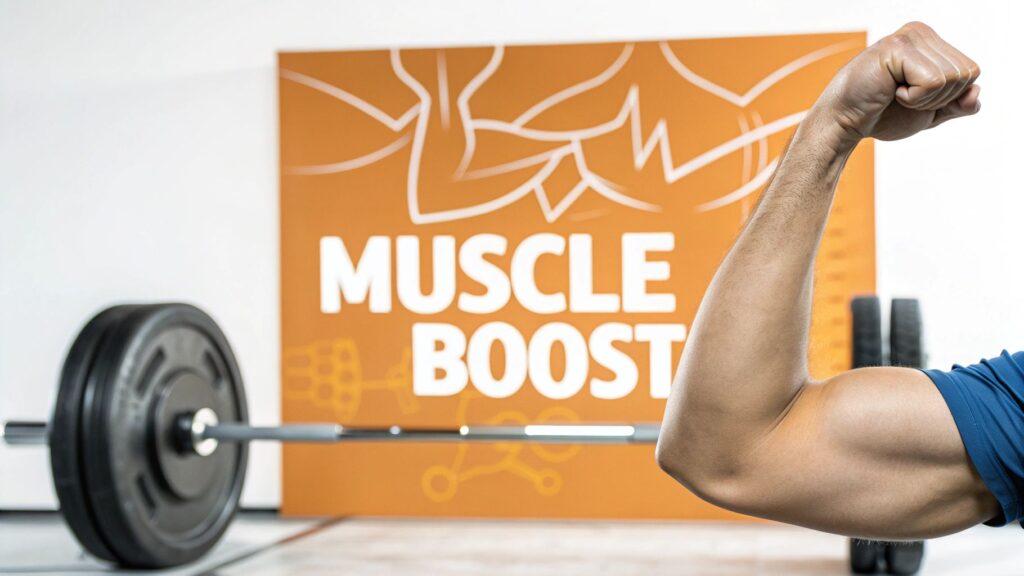When you hear about testosterone therapy muscle gain, it's easy to picture some kind of overnight, dramatic transformation. The reality, though, is a fascinating biological process that’s all about creating the perfect internal environment for your body to build and maintain lean muscle far more efficiently.
Medically supervised testosterone replacement therapy (TRT) doesn't just magically create muscle. Instead, it flips a switch, telling your body it's time to get serious about growth and repair.
The Foundation of Testosterone Therapy Muscle Gain
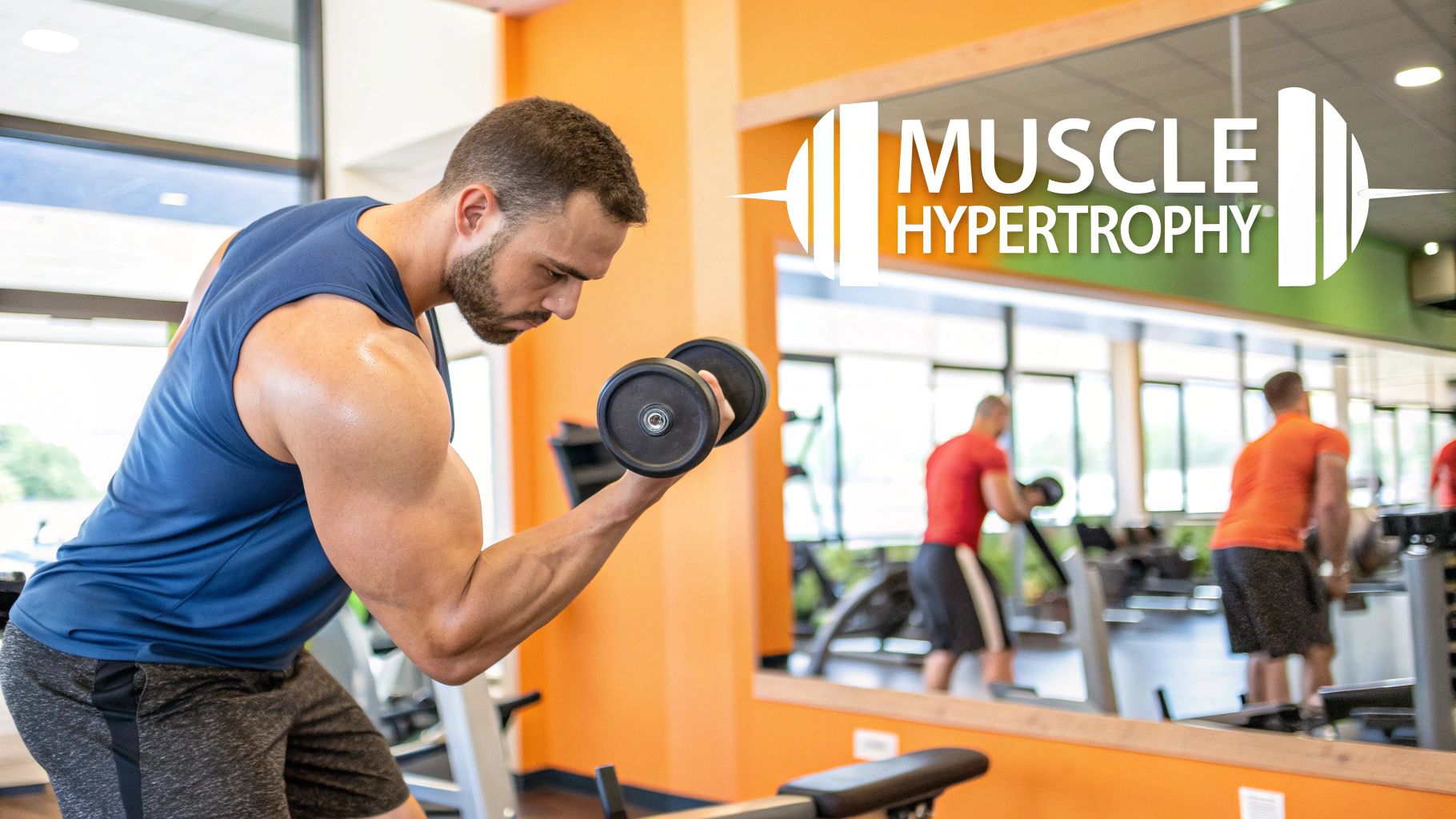
At its core, the mechanism is simple: testosterone supercharges muscle protein synthesis. This is the fundamental process your body uses to patch up the microscopic tears in muscle fibers caused by a tough workout, building them back bigger and stronger than before. With optimal testosterone levels, this repair-and-build cycle kicks into high gear.
Hypertrophy: The Engine of Muscle Growth
The key concept to get your head around is muscle fiber hypertrophy. After puberty, your body doesn't really create brand new muscle fibers. Instead, the ones you already have grow in size and volume. Think of your muscle fibers like small balloons; testosterone helps inflate those balloons, making each one larger and denser.
Testosterone is the catalyst that tells your cells to pull in more protein and expand. Research has long confirmed this is the main route for testosterone-driven growth. One foundational study showed a direct, dose-dependent link between testosterone levels and muscle size. Researchers saw that the cross-sectional area of muscle fibers grew right alongside testosterone concentration, proving the hormone makes existing fibers bigger, not more numerous. You can read the full research about these findings to see the cellular mechanics in detail.
"Testosterone therapy does not create muscle on its own. It amplifies the body's natural response to stimulus, turning your diet and exercise efforts into more pronounced and sustainable muscle growth."
This is a critical point. While TRT sets the stage for growth, your actions—hitting the weights and eating enough protein—are what actually build the muscle. The therapy just ensures every single rep and every gram of protein you consume packs a much bigger punch.
Distinguishing Mass from Strength
It's also important to separate muscle mass from functional strength. While testosterone therapy is incredibly reliable for increasing lean body mass, the gains in raw strength can be a bit more variable. You will get bigger, but just how much stronger you get depends on other factors, like your specific training program and your body’s neurological adaptations.
Let's quickly summarize how testosterone therapy works to build muscle and what you can expect from a medically supervised program.
Quick Overview of Testosterone Therapy for Muscle Gain
This table breaks down the primary mechanisms and outcomes you can expect from medically supervised testosterone therapy.
| Aspect | Key Mechanism | Primary Outcome |
|---|---|---|
| Metabolic State | Shifts body from a catabolic (breakdown) state to an anabolic (building) state. | Enhanced ability to build and retain lean muscle mass. |
| Cellular Action | Increases muscle protein synthesis and promotes muscle fiber hypertrophy. | Existing muscle cells grow larger, leading to visible increases in size. |
| Synergistic Effect | Amplifies the body's response to resistance training and proper nutrition. | Maximized results from gym workouts and a protein-rich diet. |
This table shows it's a multi-faceted process. TRT creates the right chemical environment, the cells respond by growing, and your lifestyle choices determine the final outcome.
Key points to remember:
- Anabolic Environment: TRT puts your body in a "building" state, making it easier to gain muscle and harder to lose it.
- Cellular Growth: The main effect is the enlargement of individual muscle cells, which is what you see as increased muscle size.
- Synergistic Effects: You'll see the best results when you pair the therapy with a solid resistance training program and adequate protein intake.
Understanding these fundamentals gives you a clear, realistic picture of how testosterone therapy muscle gain truly works. It's not a shortcut, but a powerful medical tool that restores your body’s natural potential for growth, repair, and vitality.
The Science Behind Testosterone and Muscle Growth
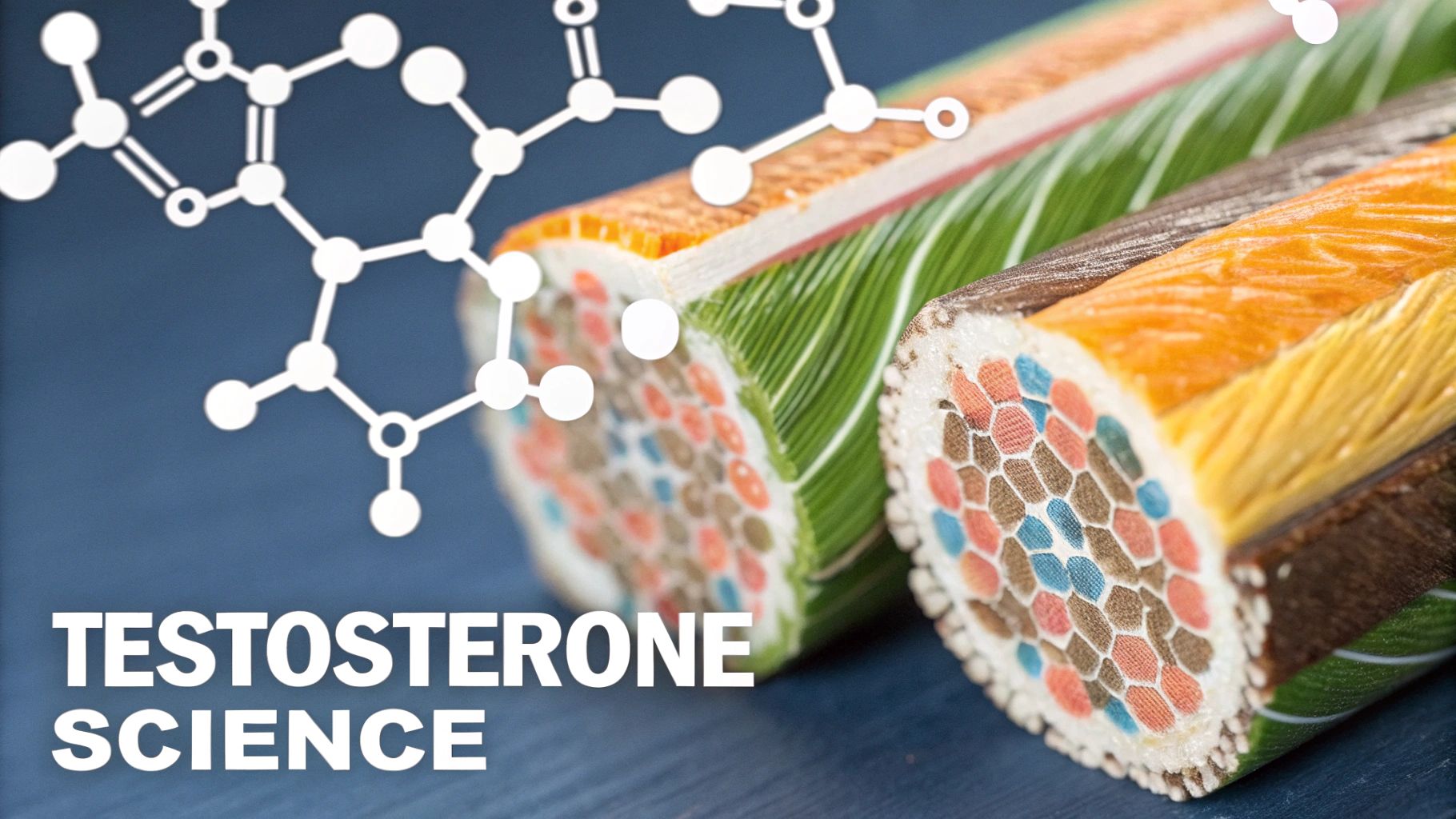
To really get why testosterone therapy muscle gain works so well, we need to zoom in and see what's happening at the microscopic level. Testosterone isn't just a blunt instrument for adding bulk; it's a sophisticated signaling molecule. Think of it as the conductor of an orchestra, coordinating a complex series of biological events that turn your hard work in the gym into real, tangible muscle.
Imagine your muscle cells are like locked rooms, each holding the potential for growth. Testosterone is the master key. As it travels through your bloodstream, it seeks out and binds to specific locks inside your muscle cells called androgen receptors.
This connection is the single event that kicks the entire muscle-building engine into high gear. It sets off a chain reaction of cellular commands, telling the cell's nucleus—its command center—to ramp up production. The main directive? Fire up muscle protein synthesis.
The Role of Protein Synthesis
Muscle protein synthesis (MPS) is the bedrock process of repairing and rebuilding muscle tissue. Every time you lift weights, you create tiny micro-tears in your muscle fibers. MPS is the biological construction crew that comes in to fix this damage, but it doesn't just patch things up—it builds the fibers back bigger and stronger than they were before.
Testosterone acts as the project foreman for this crew. By unlocking those androgen receptors, it sends a powerful signal to:
- Speed up the repair rate: Your body becomes far more efficient at fixing muscle damage after a workout.
- Improve nutrient delivery: Muscle cells become more receptive to amino acids, which are the essential building blocks for new muscle.
- Amplify anabolic signals: The entire cellular environment shifts from a state of maintenance to one of aggressive growth.
What this means is that with optimized testosterone levels, your body's response to your training is magnified. The stimulus from your workout gets translated into more substantial and efficient muscle growth, letting you see better results from the exact same effort.
Preventing Muscle Breakdown
Building new muscle is only half the story; protecting the muscle you already have is just as critical. Your body is in a constant state of flux, simultaneously building tissues (anabolism) and breaking them down (catabolism). For you to actually gain muscle, the rate of building has to consistently outpace the rate of breakdown.
This is another area where testosterone plays a vital defensive role. It actively works to block catabolic hormones like cortisol, which is notorious for chewing up muscle tissue, especially during periods of stress. By putting the brakes on muscle breakdown, testosterone helps you hold onto your hard-earned gains.
This dual-action mechanism—supercharging protein synthesis while slamming the brakes on muscle breakdown—creates a powerful net-positive anabolic environment. It’s like getting a raise at work while also cutting your monthly expenses, leading to more money in the bank or, in this case, more muscle on your frame.
This favorable hormonal landscape is what makes sustained muscle growth possible. It ensures your body is primed for growth not just in the hour after a workout, but around the clock.
The Impact on Satellite Cells
Beyond its direct action on muscle fibers, testosterone also recruits another key player in the growth game: satellite cells. These are specialized stem cells that hang out on the outside of your muscle fibers, waiting to be called into action. When you train hard, they get activated.
Testosterone boosts the number of available satellite cells and improves their ability to merge with existing muscle fibers. This fusion process donates new nuclei to the muscle cells, which dramatically increases their long-term capacity for growth and repair. Think of it as upgrading a factory's machinery—it allows for bigger and better output down the line.
This cellular upgrade is a crucial part of how testosterone therapy supports not just immediate gains but also your long-term potential for building a stronger, more muscular physique. The whole process is a beautifully interconnected system where testosterone acts as the master regulator, making sure every part works together toward the common goal of growth.
Setting Realistic Expectations for Your Results
When you start testosterone therapy for muscle gain, it's easy to get caught up in flashy online claims. But the real journey is a marathon, not a sprint. We need to separate the marketing hype from the evidence-based reality of how your body will actually change. This isn't an overnight transformation; it's a gradual process, with different benefits showing up at different times.
Think of testosterone therapy as a powerful amplifier, not a magic wand. It creates the perfect internal environment for growth, but the final results are still sculpted by your own effort and biology. It’s like upgrading your car's engine—you've got more horsepower, but you still have to drive it right to win the race.
The Timeline for Tangible Changes
One of the first things you'll probably notice won't be in the mirror—it'll be in your day-to-day life. Many men report a solid boost in energy, mood, and libido within the first few weeks. These early wins are fantastic, but they happen long before any significant muscle growth becomes visible.
Building new muscle is a metabolically expensive job that takes time. Your body has to adapt to the new hormonal signals, fire up protein synthesis, and start laying down new muscle fibers. That physiological shift just doesn't happen instantly.
This infographic lays out a clear visual timeline of what to expect and when.
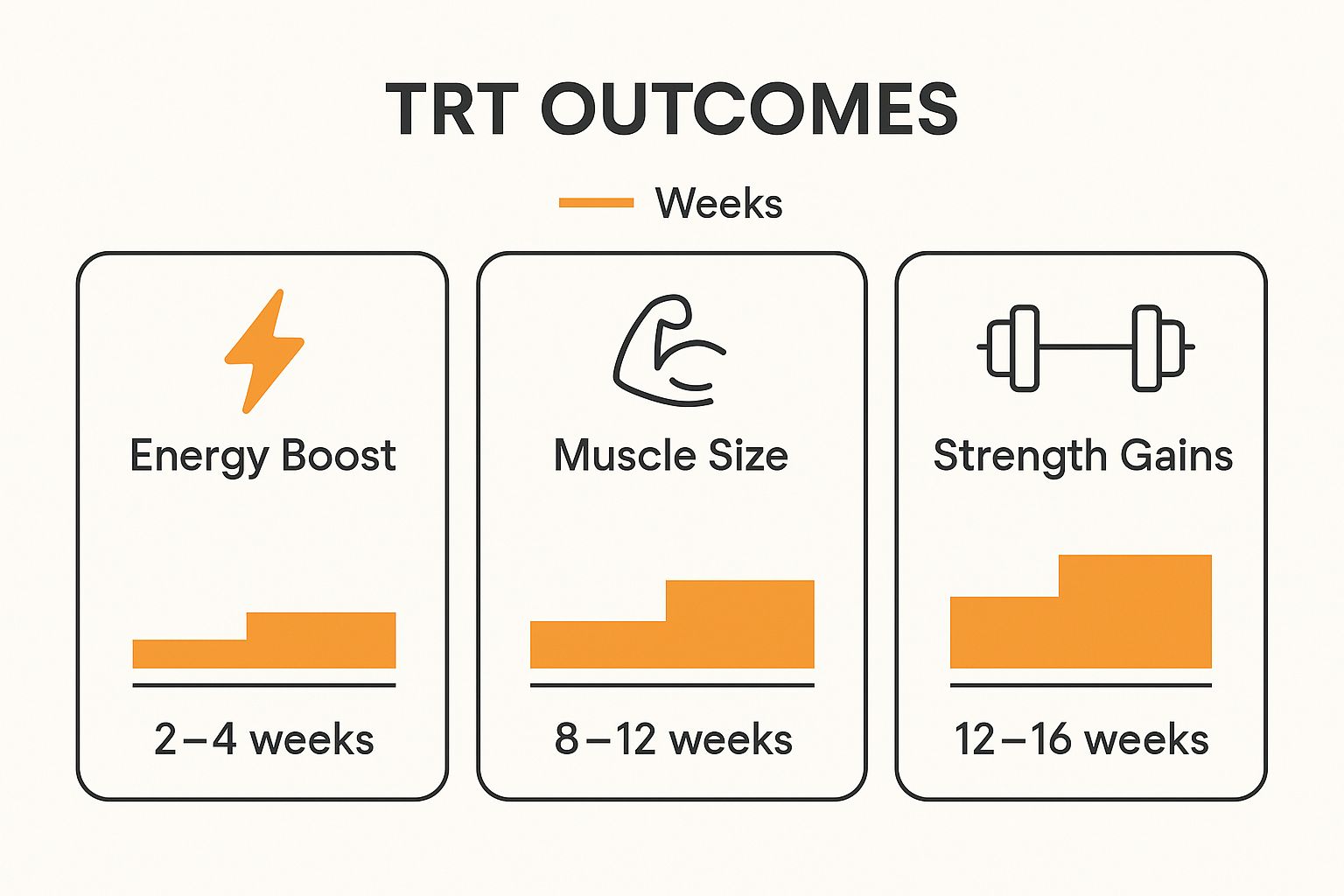
As you can see, boosts in energy and drive are early victories. But getting bigger and stronger? That requires more patience and consistent work.
Key Variables That Influence Your Progress
No two guys respond to testosterone therapy the exact same way. Your personal results are a unique cocktail of several interconnected factors that dictate the pace and scale of your progress. Understanding these variables helps you set goals that are actually achievable.
Here’s what really moves the needle:
- Your Baseline Levels: Men starting with clinically low testosterone often see more dramatic changes than those who are just looking for an edge from the higher end of the normal range.
- Age and Genetics: Your age and genetic blueprint play a huge role in how your body responds to hormonal shifts and builds muscle. It's just a fact of life.
- Diet and Nutrition: You can't build muscle out of thin air. A diet loaded with protein and enough calories to fuel growth isn't just a suggestion—it's non-negotiable.
- Training Intensity: Testosterone therapy supercharges your response to training. A consistent, challenging resistance program is what actually pulls the trigger for muscle hypertrophy.
It's a synergistic relationship: the therapy optimizes your body's potential, but your lifestyle choices—what you eat and how you train—are what unlock that potential. Neglecting diet and exercise will severely limit your results.
Muscle Size Versus Functional Strength
Here’s a critical distinction you need to make: gaining muscle mass isn't the same thing as gaining functional strength. While testosterone is incredibly effective at packing on lean body mass, the impact on your pure, raw strength isn't always as direct. This means you can get noticeably bigger without a proportional jump in how much you can actually lift.
This isn't just anecdotal; it's backed by clinical observations. For instance, one cross-sectional study found that while higher natural testosterone levels were positively linked to greater muscle mass in men, they weren't significantly tied to measures of muscle strength, like grip strength. This suggests testosterone's main job is building the muscle tissue itself, not necessarily improving its functional power. You can learn more about these findings and the science behind the mass-versus-strength distinction.
Ultimately, your testosterone therapy muscle gain journey is a long-term investment. By understanding the timeline, appreciating the variables at play, and locking in your diet and training, you can set realistic, motivating goals and work effectively toward crushing them.
Choosing the Right Administration Method
Once you and your doctor have decided that testosterone therapy for muscle gain is the right move, the next big question is a practical one: how are you going to get the testosterone into your system? The delivery method is far from a minor detail. It’s a critical piece of the puzzle that directly impacts the stability of your hormone levels, your daily convenience, and ultimately, how consistent your results will be.
Think of it like setting a thermostat for your body. The goal isn’t just to turn up the heat; it's to maintain a steady, optimal temperature. In this case, you want a stable testosterone level to create the perfect anabolic environment for growth. Wild swings—high peaks followed by deep troughs—can sabotage your progress and invite unwanted side effects. A well-designed protocol aims to mimic your body's natural rhythm, keeping you right in that sweet spot for building muscle.
Intramuscular Injections
Testosterone injections are one of the most common, time-tested, and cost-effective methods out there. They are administered directly into the muscle, usually the glute or deltoid, which allows for extremely precise and predictable dosing.
Because the testosterone is suspended in an oil-based depot within the muscle, it's released slowly and steadily. This creates a far more stable hormonal environment compared to methods that can cause daily fluctuations, a huge benefit for sustaining muscle protein synthesis. While some guys are hesitant about self-injecting at first, most find the process becomes quick and routine with proper instruction.
For a full breakdown of how injections stack up against other options, exploring the differences between testosterone oral vs. injection can give you a clearer picture to discuss with your doctor.
Transdermal Gels and Creams
For those who’d rather skip the needle, transdermal gels and creams are a popular alternative. You apply them to the skin daily, and they provide a steady absorption of testosterone directly into the bloodstream.
This method offers incredible convenience and can easily become part of a daily routine, just like brushing your teeth. However, it demands real diligence. You have to be extremely careful to avoid transferring the gel to others, especially women and children, through skin-to-skin contact. You also need to make sure your skin is clean and dry before applying to get proper absorption. Inconsistent application will lead to fluctuating hormone levels, which can put the brakes on consistent muscle gain.
Key Consideration: The best administration method is the one you can stick with consistently and that keeps your testosterone levels stable and in your optimal range. Consistency is the absolute cornerstone of successful therapy.
Other Administration Options
Beyond the two most common methods, a few other options exist, each with its own set of pros and cons that might fit a particular lifestyle or preference.
- Subcutaneous Pellets: These are tiny, rice-sized pellets implanted just under the skin, usually in the hip area. They slowly release testosterone over 3 to 6 months, offering a "set-it-and-forget-it" convenience that many guys love. The downside? It requires a minor in-office procedure for both insertion and removal, and the dosage can't be easily adjusted once the pellets are in place.
- Oral Capsules: Modern oral testosterone formulations have come a long way, overcoming the liver toxicity issues that plagued older versions. They offer a simple, needle-free option but often need to be taken with a fatty meal to ensure proper absorption. This can be a drawback if it doesn't align with your dietary plan.
- Nasal Gels: This method involves applying a gel inside the nostrils multiple times per day, providing very rapid absorption. However, the need for such frequent dosing is a major hurdle for most people to maintain consistently, which can easily lead to unstable hormone levels.
To help you compare these options at a glance, we've put together a quick overview.
Comparing Testosterone Administration Methods
This table provides a high-level look at the common delivery methods for testosterone therapy, highlighting their advantages and disadvantages to help guide your conversation with your healthcare provider.
| Method | Pros | Cons |
|---|---|---|
| Intramuscular Injections | Highly cost-effective; precise dosing; stable hormone levels between injections. | Requires self-injection; potential for injection site soreness. |
| Transdermal Gels/Creams | Non-invasive; easy daily application; steady hormone absorption. | Risk of transference to others; requires careful daily routine; can cause skin irritation. |
| Subcutaneous Pellets | Long-lasting (3-6 months); "set-it-and-forget-it" convenience; no daily action required. | Requires a minor in-office procedure; dosage is not easily adjustable once implanted. |
| Oral Capsules | Needle-free and convenient. | Must be taken with fatty meals for absorption; may require multiple doses per day. |
| Nasal Gels | Rapid absorption into the bloodstream. | Requires frequent daily dosing (2-3 times); can be inconvenient to maintain. |
Ultimately, choosing the right method is a team decision made by you and your doctor. Your lifestyle, personal preferences, and specific health needs all come into play. The goal is always the same: to pick a protocol that keeps your testosterone levels steady, empowering your body to maximize the muscle-building benefits of your therapy.
What Real World Results Look Like
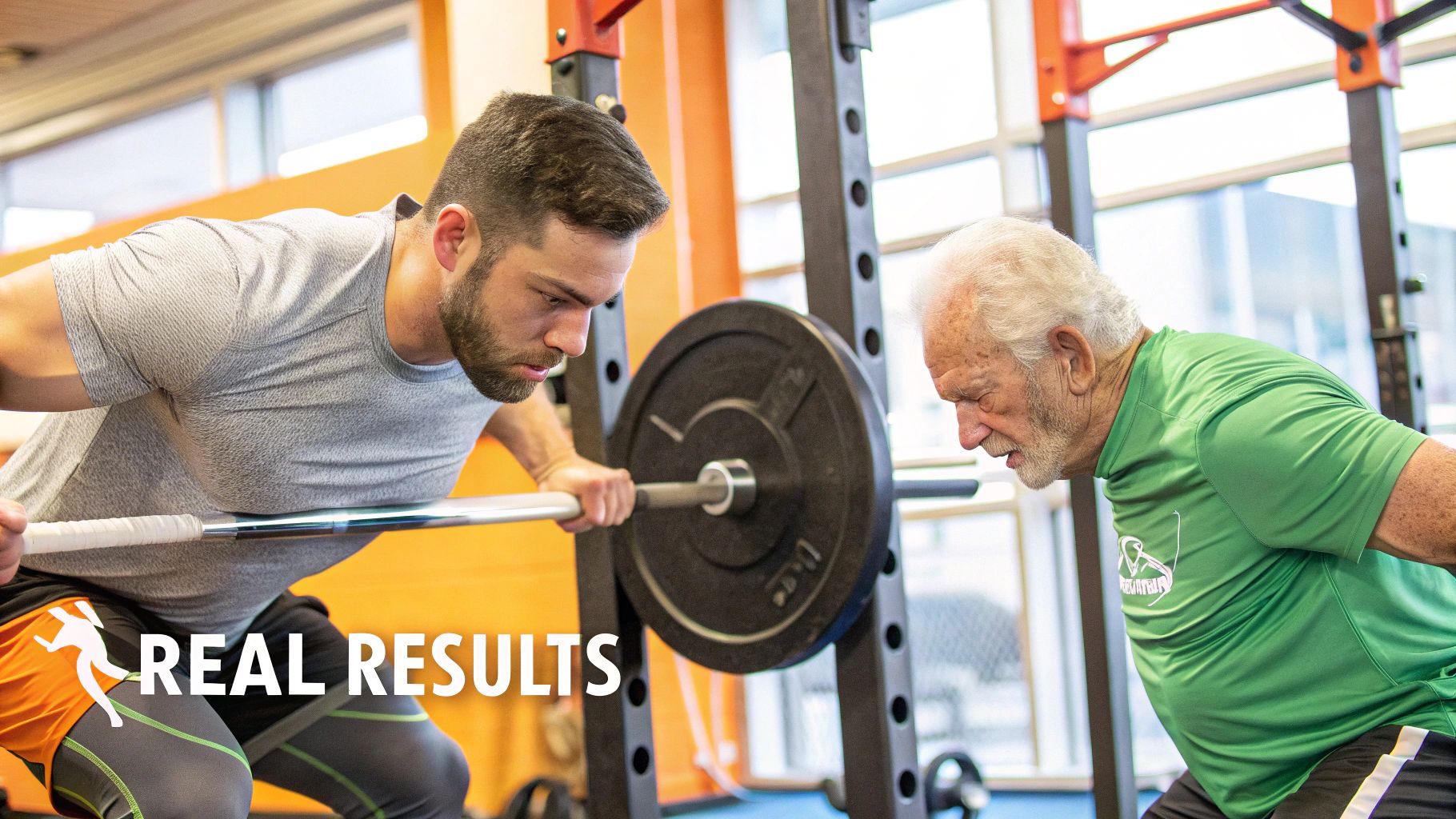
So, what does all this science look like in the real world? When we move from the lab to the gym, the results of testosterone therapy muscle gain become clear. You can see it in clinical data, but more importantly, you can hear it in patient stories—it's about more than just numbers on a chart.
Of course, results vary based on your age, starting health, and how hard you hit the gym. But the common thread is a feeling of physical restoration and renewed vitality.
Restoring What Was Missing
For younger men diagnosed with clinical hypogonadism, getting their testosterone back into an optimal range can be dramatic. These guys often see a powerful response, with noticeable increases in lean muscle and a drop in body fat over the first year.
Their bodies are finally being given the hormonal tools they were missing all along. Suddenly, all that hard work in the kitchen and the weight room starts paying off. This isn't just about looking better; it's about reclaiming the physical confidence that low testosterone stole.
Combating Age-Related Muscle Loss
For older men, the goal shifts. It's less about building a beach body and more about fighting back against age-related muscle loss, or sarcopenia. It’s a quiet thief—after age 30, men can lose 3-5% of their muscle mass every decade. Testosterone therapy is a powerful tool in that fight, helping to preserve and rebuild that vital tissue.
Sarcopenia isn't just a cosmetic issue. It has a direct impact on your mobility, balance, and ability to handle daily tasks. It increases the risk of falls and can seriously diminish your quality of life.
By restoring hormonal balance, TRT helps older men hold onto their strength and independence. The muscle they gain isn't just for show; it translates directly into real-world function, making it easier to climb stairs, carry groceries, or keep up with the grandkids. This is where therapy becomes truly profound, supporting not just muscle size but a more active, engaged life.
Clinical Evidence of Muscle and Strength Gains
These aren't just feel-good stories; the benefits are consistently backed by hard data. Study after study has shown that testosterone therapy leads to measurable increases in lean body mass. A landmark trial from 2017 gave us concrete proof in men aged 60 and older.
Over three years, men using a daily testosterone gel saw significant gains in lean body mass and physical performance. Specifically, their unloaded stair-climbing power jumped by 10.7 Watts, and their loaded power by an impressive 22.4 Watts. These aren't miracle numbers, but they are moderate, meaningful improvements that show TRT's role as a supportive tool.
This data confirms that the muscle gained through therapy translates directly into real-world strength and power. For anyone wondering what to expect, the TRT results timeline provides a great breakdown of when you might notice changes. By grounding your expectations in clinical reality, you can appreciate the steady, meaningful progress that medically supervised therapy can offer.
Understanding and Managing Potential Risks
Let's be honest: while testosterone therapy can be a game-changer for muscle gain, it's a serious medical treatment, not just a lifestyle tweak. An open conversation about the potential risks isn't meant to scare you off—it's meant to empower you.
Understanding the possible side effects is what allows you to have a smart, informed discussion with your doctor. Think of it this way: you track your progress in the gym, right? You need to be just as diligent about tracking your health with your physician. This partnership is the single best way to minimize risks and make sure your journey is both safe and successful.
Common and Manageable Side Effects
When you first start therapy, your body has to get used to a new hormonal normal. During this initial adjustment period, it's not uncommon for some men to experience a few mild side effects as things level out.
These often include:
- Acne or Oily Skin: Higher testosterone can kick your oil glands into gear, a bit like a flashback to puberty. This is usually temporary and can be handled with a good skincare routine.
- Fluid Retention: Some guys notice a bit of bloating or swelling, especially around the ankles. This is typically managed by tweaking your diet or adjusting your dose.
- Mood Fluctuations: As your system adapts, you might feel a little more irritable or notice some mood swings. A stable, well-planned dosing protocol is key to keeping this to a minimum.
These issues are generally mild and tend to fade as your doctor dials in your specific protocol. The key is to keep the lines of communication open with your medical team so they can address anything that comes up right away.
More Serious Health Considerations
Beyond those initial bumps in the road, there are more significant health metrics that demand ongoing medical supervision. This is precisely why trying to self-administer testosterone without a doctor is so incredibly dangerous. Your physician will use regular blood work to keep a close watch on several critical markers.
The absolute cornerstone of safe and effective testosterone therapy is regular medical monitoring. Those blood tests are non-negotiable—they are your best defense against potential complications, enabling early detection and swift intervention.
Key areas of focus include:
- Elevated Red Blood Cell Count (Hematocrit): Testosterone can tell your bone marrow to produce more red blood cells. If your hematocrit level climbs too high, it thickens the blood, which can increase the risk of clots or cardiovascular events.
- Prostate Health: While modern research has calmed many of the older fears about TRT causing prostate cancer, it's still a vital area to monitor. Your doctor will track your Prostate-Specific Antigen (PSA) levels to make sure everything stays healthy.
- Cardiovascular Health: The link between testosterone and heart health is complex. To manage your overall cardiovascular risk, your doctor will monitor your cholesterol levels, blood pressure, and, of course, your hematocrit.
A proactive partnership with your physician is the best way to navigate these considerations. For a more detailed look into the specifics, you can review this comprehensive guide on the potential testosterone therapy side effects and how a qualified doctor manages them.
By staying informed and actively engaged in your treatment, you can confidently chase your muscle-building goals while making your long-term well-being the top priority.
Your Questions Answered: Expert Insights on TRT and Muscle
Even after digging into the science, it's natural to have questions about how testosterone therapy fits into your own life. Let's tackle the most common ones head-on, giving you the clear, direct answers you need to move forward with confidence.
How Long Until I Actually See Muscle Gain?
While you'll probably feel a welcome surge in energy and drive within a few weeks, visible changes to your physique take a bit more patience. Most of the clinical data shows significant increases in lean body mass start showing up after 3 to 6 months of consistent therapy.
These gains don't just stop there; they often keep improving for a year or more as your body fully adapts. Just remember, your final results are a team effort between the therapy, your starting point, your dosage, and—most importantly—your dedication to diet and training.
Do I Still Have to Work Out on TRT?
Absolutely. Think of testosterone therapy as an amplifier, not an autopilot for muscle growth. It creates the perfect anabolic environment inside your body, priming it for growth, but it won't build the muscle on its own. It supercharges your body's response to the work you put in.
To get the most out of your treatment, a consistent resistance training program isn't just recommended—it's essential. The therapy makes sure that every single rep you push through contributes more effectively to building a stronger, leaner physique.
Think of it this way: TRT provides the fertile soil, but resistance training is what plants the seeds for growth. Without the stimulus of exercise, you're leaving most of your potential gains on the table.
Will I Lose My Gains if I Stop Testosterone Therapy?
Yes, it's almost certain you'll lose a large portion of the muscle you built during treatment if you stop. Once the therapy ends, your body’s testosterone levels will drop back down to your previous baseline, pulling the plug on that powerful anabolic support system.
This hormonal shift means your body simply can't sustain that extra muscle mass. That’s why a proper discontinuation plan, always guided by your doctor, is so critical for managing this transition safely and effectively.
Ready to explore how a personalized therapy plan can help you reach your goals? The team at Elite Bioscience specializes in creating physician-guided protocols to optimize your health and performance. Learn more about our approach and start your confidential health assessment today at https://elitebioscience.co.




